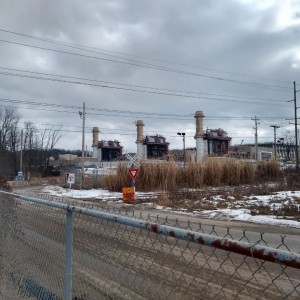From an Article by Alexis Goldsmith, Concerned Ohio River Residents, February 13, 2022
§
I met Kevin Young, a resident of Guernsey Co. Ohio, who’s life has been completely upended by the construction of the Guernsey fracked gas power station, owned by Caithness Energy LLC. This is the largest new fracked gas power plant in the US.
The plant sits on top of an abandoned coal mine, which contains thousands of shafts that run underground for miles. To stabilize the mine, the company carved injection wells every 25 feet over the site and filled them with huge amounts of toxic coal ash mixed with what residents suspect to be fracking waste water. Fracking wastewater, also called brine or produced water, contains toxic chemicals and radioactive isotopes.
For months as the mine was filled, toxic coal ash filled the air, covering every surface in Kevin’s home. Since construction began two years ago, his wife Marlene has been diagnosed with Stage 4 lung cancer. I saw the dust, which was very sticky and not like regular household dust. It felt like it had been stuck on with glue. This is what Kevin and Marlene were breathing.
Filling the mine also raised the water table and contaminated Kevin’s drinking water well. When tested, it was found his water was contaminated with what appears to be fracking contaminates, including methane, toluene, and benzene. Arsenic was also found in Kevin’s water, which he’s had to shut off as it is toxic and corrosive.
When operational, the Guernsey Power Station will be the largest single-unit fracked gas power plant in the US, at 1800 mega-watts. Yet despite the risks of filling the abandoned coal mine, no Environmental Impact Statement was conducted and very few residents even knew about the project.
Use of coal ash and fracking wastewater to fill the coal mine, only to build a fracked gas power plant, perpetuates the toxic cycle of extraction, combustion, and waste from fossil fuels. Kevin told me the site would have been perfect for a wind powered energy plant, as the wind blows consistently through the valley.
There are a number of organizations trying to understand this misguided project. Beyond Plastics, Concerned Ohio River Residents, FracTracker, Food & Water Action, Center for Coalfield Justice, and others

